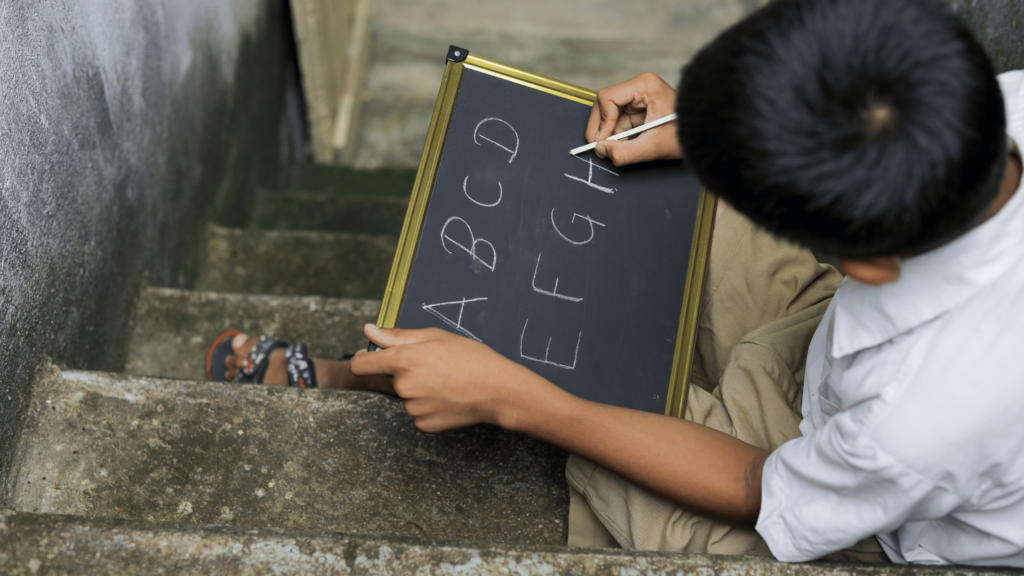We are heading more and more into digitalization and technology. Children are now adapting more to videos and keypads to read and write. Relying only on digital devices can be problematic for the children as it hampers brain development and slows down the progress of fine motor skills. And in such times, it becomes necessary for the children to have legible and neat handwriting.
A new EEG-based study by researchers at the Norwegian University of Science and Technology (NTNU) reaffirms the importance of “old-fashioned” handwriting in the 21st-century’s Computer Age. Even if students use digital pens and write by hand on an interactive computer screen, cursive handwriting helps the brain learn and remember better. These findings (Askvik, Van der Weel, & Van der Meer, 2020) were recently published in the peer-reviewed journal Frontiers in Psychology.
Handwriting is a complex art. To develop good, stylish, and legible handwriting, it is important to form letters correctly. Let us understand the letter formation, its importance, and some tips and tricks to make it easier for the children to understand the right formation.
What is letter formation of alphabets?
Letter formation refers to the process of writing or creating individual letters of the alphabet in a legible and standardized manner. It involves the correct sequence of strokes, the proper shape of each letter, and adherence to established conventions for handwriting. Letter formation is a fundamental skill taught in early education to enable effective reading and writing. Correct letter formation is a key component of effective handwriting and needs thorough understanding.
Children should not be expected to “catch” writing skills just from being given opportunities to play with pencil-and-paper activities; rather, they need to learn to master handwriting with very specific lessons! (Graham, 1999; Christensen, 2004)
Letter formation stands as a fundamental milestone for children as they embark on the journey of developing their handwriting. It necessitates the mastery of each individual letter, serving as a foundation for efficient and fluent writing. Consistent practice and opportunities to refine this skill are crucial in aiding children’s quest for proficient letter formation.
Strokes in the form of lines and curves are made in certain ways and proportions to form letters. From a specific start point, moving forward with various pulls and pushes of the pencil, the lines and curves end at a designated point. This completes the letter.
What skills are enhanced by learning letter formation?
Learning letter formation enhances a range of essential skills, including:
- Fine Motor Skills: The precise movements required for letter formation help develop fine motor control and dexterity.
- Hand-Eye Coordination: Coordinating hand movements with visual input is vital for accurate writing.
- Cognitive Skills: Letter formation engages cognitive processes such as memory, attention, and problem-solving.
- Language Skills: It reinforces letter-sound associations and contributes to phonemic awareness.
- Literacy Skills: Letter formation is a fundamental step in developing reading and writing abilities.
- Attention to Detail: Focusing on accurate letter shapes cultivates attention to detail.
- Patience and Perseverance: Practicing letter formation encourages patience and perseverance, essential for skill development.
- Confidence: Mastery of letter formation boosts self-esteem and confidence in literacy tasks.
Why is it important to teach children to form letters in the correct way?
It is extremely important for the children to understand the correct proportion and the strokes involved in forming a letter. Though it might be overwhelming for them, to avoid mistakes and challenges in further tasks, it is necessary to learn it step by step.
Some key reasons for writing the letters the right way are:
- Correct letter formation helps the child write fluently and quickly. This makes the child more confident as they enjoy writing and believe in their skills to write correctly.
- The correct letter formation helps the child understand the words precisely, which further helps them to read.
- It is worth noting that the letters formed in an incorrect way make it harder for the child to read their own handwriting. This could lead to stress and embarrassment as the child grows older and writing becomes more complex.
- Children who have not mastered consistently proper letter formation may use so much mental energy on recalling and writing the letters that they are unable to spontaneously write or appropriately respond to inquiries.
- Handwriting also develops cognitive skills. The more the child forms the letters using right strokes, more patterns are memorized which later on helps them to read fluently.
How do you teach a child letter formation?
Teaching letter formation to a child is an essential step in the early stages of literacy development. It involves helping them learn how to correctly write letters and, by extension, to read and write effectively. Here are 15 steps to teach a child letter formation:
- Start with Pre-Writing Activities: Begin by developing the child’s fine motor skills and hand-eye coordination through activities like coloring, drawing, and tracing. These activities help build the foundational skills needed for letter formation.
- Introduce the Letters: Start by teaching a few letters at a time, typically beginning with the child’s name. Choose uppercase or lowercase letters based on the child’s familiarity and development stage.
- Demonstrate Proper Formation: Show the child how to form each letter correctly. Use a large, clear model of the letter, and write it slowly while explaining the strokes and directions.
- Trace and Replicate: Provide worksheets or materials with dashed or dotted lines for the child to trace over. Encourage them to replicate the letter’s shape by following the lines.
- Use Multi-Sensory Techniques: Engage multiple senses for a holistic learning experience. Allow the child to write letters in sand, on a whiteboard, or with finger paint. Multi-sensory activities help reinforce memory and understanding.
- Practice Handwriting Worksheets: Introduce age-appropriate handwriting worksheets designed for letter formation practice. These often include guided lines for each letter.
- Offer Praise and Encouragement: Praise the child’s efforts, focusing on their attempts rather than perfection. Encourage them to keep trying and celebrate their progress.
- Correcting Mistakes Gently: When the child makes mistakes in letter formation, correct them gently by showing the correct way. Avoid excessive criticism, which can discourage them.
- Frequent Repetition: Repetition is key to building muscle memory. Encourage the child to practice regularly, reinforcing the correct formation of each letter.
- Engage in Games and Activities: Make learning fun by incorporating games and activities that involve letter formation. This can include letter puzzles, magnetic letters, or writing in a salt tray.
- Develop a Consistent Writing Habit: Encourage the child to write letters regularly, such as practicing a specific letter each day. This routine helps solidify letter formation skills.
- Progress to Words and Sentences: Once the child is comfortable with individual letters, guide them in forming words and simple sentences. Practice connecting letters to form words.
- Transition to Cursive (If Applicable): If cursive writing is part of the curriculum, introduce it when the child is ready. Start with cursive letters and guide them in connecting these letters into words.
- Encourage Independent Writing: As the child’s confidence and skills grow, allow them to write independently. Provide opportunities for them to write letters, notes, or stories on their own.
- Regular Review: Periodically review letter formation to ensure that the child maintains correct techniques and good handwriting habits.
Remember that every child progresses at their own pace, so be patient and supportive throughout the process. Consistency, practice, and a positive learning environment are key to teaching letter formation effectively.
Tips and tricks for mastering correct letter formation
Is your child struggling to form letters correctly? These letter formation tips and strategies may help!
- Start with lines and patterns. There should be no hurry to teach letters immediately. The first thing a child should understand is lines and patterns—straight line, sleeping line, and slant line are the basic ones. The patterns of a half circle on both the left and right side of the hemisphere and a half circle upside down are to be taught on the first stage.
- Let the child trace the letters first and then begin to write. Tracing would help the child comprehend the shape of the letter with the right directions and proportions. Writing would be easier after tracing.
- To help the child form the letter correctly, teaching the alphabet in a specific order is key! Teach the letters as per family. There are letters that look alike or maybe have some common traits. like n and m, g and q. Few letters follow the same pattern, like b and d. It is easier for the children to comprehend the letter shape based on family descriptions.
- Use the multi-sensory approach. Give the sandpaper alphabets or the rice tray, or take the children to the sandpit. Let them trace and form the letters in various modes. This would help them understand the right flow of the letter.
- Ensure the right patterns and strokes are taken. Some children are smart enough to recall the right shape of the letter, and they just write it whichever way. But it is absolutely necessary that a child follow the proper flow of the world while writing the letter. from top to bottom and left to right.
Tackling confusing letters
Some letters in the English language look alike or are difficult to differentiate at first glance. like p and q or b and d. Such letters can only be tackled by tracing the patterns continuously. Allow the child to trace these letters and say them out loud as they trace. More tracing of these letters will help the child understand the right direction and pattern of each letter.
Conclusion
There are tons of activities and worksheets available on the internet that help the child trace the letters. Guide them through strokes and patterns to form a letter correctly. Get your hands on the worksheets, try the ideas and strategies mentioned above and allow the child to connect lines through various patterns. Think of some out-of-the-box activities too and share some ideas with us. This would indeed help other parents too!
FAQs on Alphabet Letter Formation
- What is letter formation for kids?
Letter formation for kids refers to the process of learning how to write letters of the alphabet correctly. It involves teaching them the proper strokes, direction, and shape of each letter. This foundational skill is essential for developing handwriting and literacy skills, enabling children to read and write effectively.
- What letter to teach kids first?
The choice of which letter to teach kids first can vary, but many educators and parents start with teaching a child the letters in their name. This approach provides a meaningful and personalized context for learning. Alternatively, some prefer to begin with the letters that are simplest to form, such as “C,” “O,” or “S.” These letters have basic shapes and require fewer strokes. The ultimate goal is to make the learning experience engaging and enjoyable for the child, setting a positive tone for further alphabet exploration.
- What is the right age for a child to start writing letters?
Children typically begin to learn how to write letters between the ages of 3 to 5. At this stage, they develop the fine motor skills necessary for basic letter formation. However, the exact age varies, as readiness depends on the child’s physical and cognitive development, as well as individual interest.
Citation / References
- Letter Families. (2022, October 6). WordPress.com. https://teachhandwriting.blog/tag/letter-families/
- Rigg, D. (2021, December 16). The Importance of Teaching Handwriting for Cognitive Development. PLD – Promoting Literacy Development. https://pld-literacy.org/the-importance-of-teaching-handwriting-for-cognitive-development/
- Letter Formation Tips and Strategies. (n.d.). OT Mom Learning Activities. https://www.ot-mom-learning-activities.com/letter-formation-tips.html





